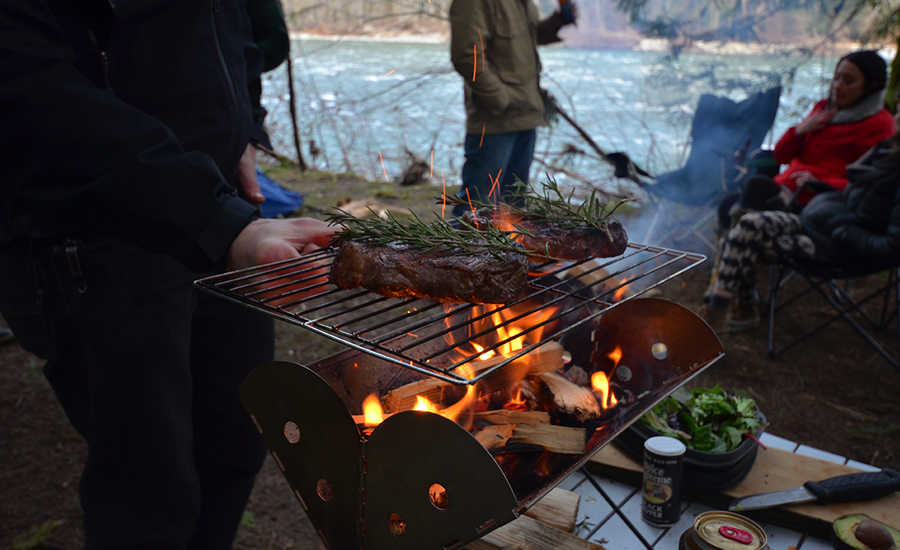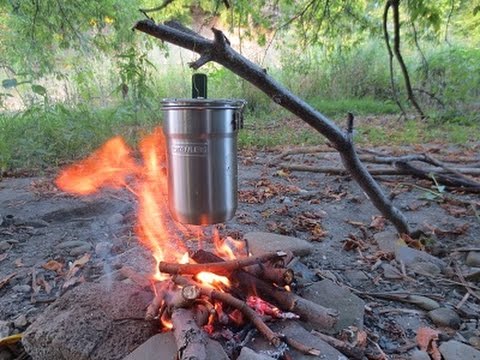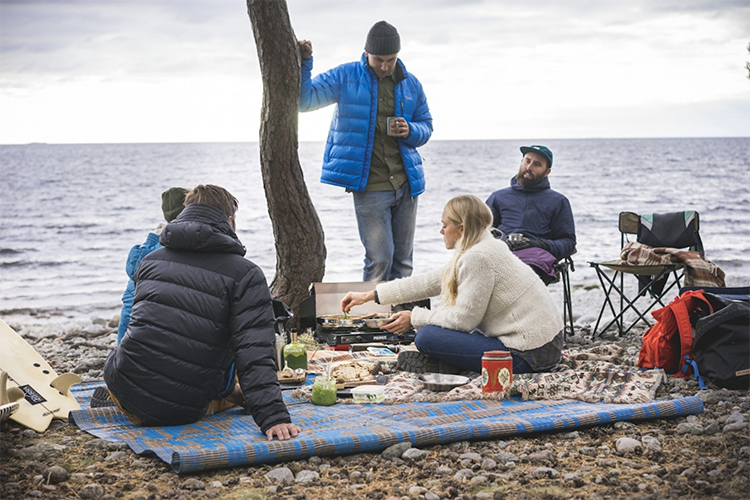Cast-iron cookware and beefy coolers show a new willingness to forgo weight restrictions in the name of durability.
This summer’s camp kitchen accommodates high-end consumers who value their creature comforts and expect to take them along when sleeping under the stars.
“The trend follows pretty closely the interest in gourmet/foodie culture in the U.S.,” said Peter Pontano, director of marketing and product development at Industrial Revolution. “With more importance and relevance being put on food in our culture, we are constantly surrounded with information and the presentation of ‘good food’ and good-food preparation.”
That extends to those cooking in the great outdoors.
Brands are lowering the barrier to entry for outdoor recreationists more likely to reach the campsite via Ford than foot. Expect to see a decrease in consumer sensitivity to the weight of their kitchenware — after all, as car campers they’re hauling gear in their car, not on their backs — and an increase in consumer sensitivity to the ingredient list — GMO-free fare and all-natural based ingredients are now on the menu.
And as consumers have proved willing to open their wallets for high-end coolers, brands are upping their tech game to offer more durable options that deliver long-term insulation properties.
Overall, there’s a push toward comfort rather than going hardcore. “These days the casual side of the outdoors is embraced by the whole industry,” said Eric Shear, Stanley’s director of global product management. “Great times outside with the people you care about don’t have to involve challenge seeking, and for many brands, design principles have been reexamined to ensure this shift is incorporated properly.”
An Elevated Camping Experience
The camp kitchen category has undergone a transformation in recent years as it caters to consumers who spend less time on the trail and more time cooking elaborate and fresher meals. “Young people are more focused on the relaxing location they arrive to than the journey to get there,” said Jeremy Dodge, marketing manager at Mountainsmith.
There are many reasons for the shift toward a plusher campsite. One, the increase in urbanization means consumers have a harder time getting outside as much as they would like. When they do exchange their skyscrapers for more scenic vistas, they want the experience to be enjoyable, not taxing. Two, these consumers tend to be less practiced in outdoor cooking methods and need more user-friendly equipment. And third, they like — and expect — good food.
Notably, the cultural swing seen in everyday life toward well-prepared food made from responsibly sourced, good-for-you ingredients is making inroads in the camping kitchen space. And it no longer carries the stigma of “glamping,” explained Industrial Revolution’s Pontano. “In the same way ‘gourmet’ food has lost the preconception of being ‘snobby,’ … you can be hardcore and like good food and drinks,” he said. “We are surrounded with great, innovative fare. Why not enjoy the same while outdoors?”
More Weight? Why Not?
Dutch ovens and skillets were the original frontiersman cooking vessels, and today’s consumers are returning to those roots. Because so many recreationists are setting up camp close to their cars, we’re seeing an uptick in heavier cooking equipment. The clearest examples of this trend: the rise in two-burner stoves and, in particular, cast-iron cookware.
“Part of the increase is that outdoor cooks, especially new people cooking outdoors, are becoming more attuned to a wider variety of recipes that can be prepared in cast iron,” said Mark Kelly, PR and advertising manager for Lodge Cast Iron Company. Cast-iron skillets are “much more versatile than most cooks can imagine. It is considered the best pan for searing steaks and other pieces of meat, but it can also be used to sear more delicate items like salmon, tuna, trout and other fish.”
For consumers heading farther down the trail, brands offer seasoned carbon steel as a lighter weight alternative to cast iron, which is faster to heat up and cool down. Collapsibility is another must-have “because it minimizes space in your backpack once it is empty,” said Holly Hansen, marketing communications manager for Avex.

Good-To-Go Founder Jennifer Scism (right) with her husband and business partner, David Koorits Photo courtesy Good-To-Go
Campsite Gourmet
Ok, so Bear Grylls’ style of eating snakes, spiders and grubs was never a pastime of the general camping public, but it’s clear that backpacking fare has been taking it up a few nutritional notches of late. The most noticeable difference is the number of brands going gluten-free and touting nutrition labels with recognizable ingredient lists. A few take it further with organic and non-GMO offerings.
The change is driven by today’s more conscious consumer, explained Jennifer Scism, chef and co-founder of Good-To-Go. In the past, backpackers focused entirely on the gear — how light the pack was, the added ounces of one stove variety versus another — and forgot about the type and quality of the calories. “Food became the bottom choice. They would throw in some ramen noodles and then figure, ‘I’ll eat crappy for two days and be fine.’ Now, I think people are realizing that food and nutrition is really important, especially for good energy levels,” she said.
Cuisine is also taking on an international twist as manufacturers offer globally inspired fare —and we’re not just talking about the typical pasta primavera and beef stroganoff. This season look for exciting new flavors like Indian vegetable korma from Good-To-Go, chicken piccata from Backpacker’s Pantry and New York-style cheesecake from Mountain House. “Consumers want more flavorful meals in this category,” said Melissa Fukushima from Backpacker’s Pantry. “Consumers want a meal that they may not typically create at home, and/or one that has more complex flavors than the DIY meals typically provide.”
The Big Chill
Whether it’s a hunter deep in the backcountry who needs to prevent his meat from spoiling or a car camper who expects his beer to still be cold after three days in the woods, consumers have heightened expectations from their coolers. As a result, brands are tweaking the technology to offer highly durable products that keep items colder for longer.
In addition to upping the amount of foam and adding robust lid gaskets, many manufacturers are turning to rotational-molded construction. Built through a slow-baking process that creates a thicker, more durable wall and made in a single, continuous piece, roto-molded coolers — as they’re commonly called — have greater impact strength and greater ice retention due to thicker foam and heavier walls.
Brands are also tailoring products to a consumer base with an anti-consumerism, “buy it for life” mentality. These buyers want quality products, and they’re willing to pay for them. “We’re seeing a movement away from the disposable lifestyle,” said DJ Bell, Yeti’s director of product marketing. “People not only want to make purchase decisions that are better for the environment, but of products that stand up to the elements and last for years.”
Lead photo courtesy Industrial Revolution













